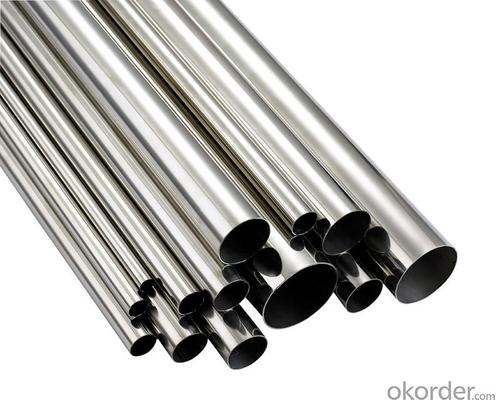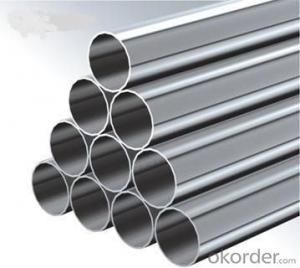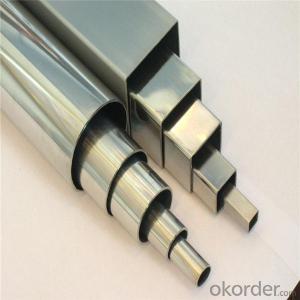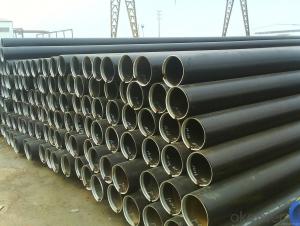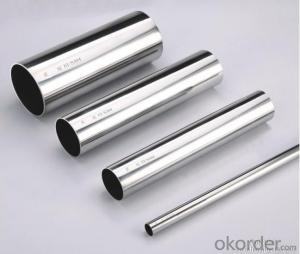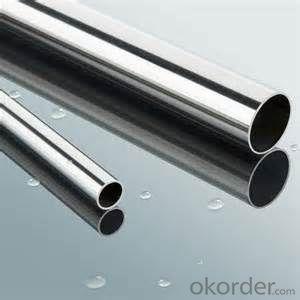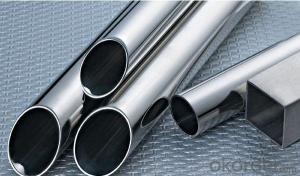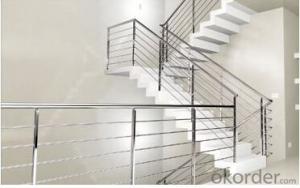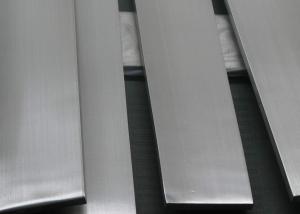STAINLESS STEEL FLOWER PIPE 304 MATERIAL
- Loading Port:
- China Main Port
- Payment Terms:
- TT OR LC
- Min Order Qty:
- -
- Supply Capability:
- -
OKorder Service Pledge
OKorder Financial Service
You Might Also Like
Description:
Stainless Steel Pipe
Material:
304 321 316 310
Packing:
In bundle
MOQ:
5 TONS
Comparison of standardized steels
| EN-standard Steel no. k.h.s DIN | EN-standard Steel name | SAE grade | UNS |
|---|---|---|---|
| 1.4109 | X65CrMo14 | 440A | S44002 |
| 1.4112 | X90CrMoV18 | 440B | S44003 |
| 1.4125 | X105CrMo17 | 440C | S44004 |
| | | 440F | S44020 |
| 1.4016 | X6Cr17 | 430 | S43000 |
| 1.4408 | G-X 6 CrNiMo 18-10 | 316 | |
| 1.4512 | X6CrTi12 | 409 | S40900 |
| | | 410 | S41000 |
| 1.4310 | X10CrNi18-8 | 301 | S30100 |
| 1.4318 | X2CrNiN18-7 | 301LN | |
| 1.4307 | X2CrNi18-9 | 304L | S30403 |
| 1.4306 | X2CrNi19-11 | 304L | S30403 |
| 1.4311 | X2CrNiN18-10 | 304LN | S30453 |
| 1.4301 | X5CrNi18-10 | 304 | S30400 |
| 1.4948 | X6CrNi18-11 | 304H | S30409 |
| 1.4303 | X5CrNi18-12 | 305 | S30500 |
| | X5CrNi30-9 | 312 | |
| 1.4541 | X6CrNiTi18-10 | 321 | S32100 |
| 1.4878 | X12CrNiTi18-9 | 321H | S32109 |
| 1.4404 | X2CrNiMo17-12-2 | 316L | S31603 |
| 1.4401 | X5CrNiMo17-12-2 | 316 | S31600 |
| 1.4406 | X2CrNiMoN17-12-2 | 316LN | S31653 |
| 1.4432 | X2CrNiMo17-12-3 | 316L | S31603 |
| 1.4435 | X2CrNiMo18-14-3 | 316L | S31603 |
| 1.4436 | X3CrNiMo17-13-3 | 316 | S31600 |
| 1.4571 | X6CrNiMoTi17-12-2 | 316Ti | S31635 |
| 1.4429 | X2CrNiMoN17-13-3 | 316LN | S31653 |
| 1.4438 | X2CrNiMo18-15-4 | 317L | S31703 |
| 1.4362 | X2CrNi23-4 | 2304 | S32304 |
| 1.4462 | X2CrNiMoN22-5-3 | 2205 | S31803/S32205 |
| 1.4539 | X1NiCrMoCu25-20-5 | 904L | N08904 |
| 1.4529 | X1NiCrMoCuN25-20-7 | | N08926 |
| 1.4547 | X1CrNiMoCuN20-18-7 | 254SMO | S31254 |
Stainless steel’s resistance to corrosion and staining, low maintenance and familiar lustre make it an ideal material for many applications. There are over 150 grades of stainless steel, of which fifteen are most commonly used. The alloy is milled into coils, sheets, plates, bars, wire, and tubing to be used in cookware, cutlery, household hardware, surgical instruments, major appliances, industrial equipment (for example, in sugar refineries) and as an automotive and aerospace structural alloy and construction material in large buildings. Storage tanks and tankers used to transport orange juice and other food are often made of stainless steel, because of its corrosion resistance. This also influences its use in commercial kitchens and food processing plants, as it can be steam-cleaned and sterilized and does not need paint or other surface finishes.
Stainless steel is used for jewelry and watches with 316L being the type commonly used for such applications. It can be re-finished by any jeweler and will not oxidize or turn black.
Some firearms incorporate stainless steel components as an alternative to blued or parkerized steel. Some handgun models, such as the Smith & Wesson Model 60 and the Colt M1911 pistol, can be made entirely from stainless steel. This gives a high-luster finish similar in appearance to nickel plating. Unlike plating, the finish is not subject to flaking, peeling, wear-off from rubbing (as when repeatedly removed from a holster), or rust when scratched.
Architecture[edit]
Stainless steel is used for buildings for both practical and aesthetic reasons. Stainless steel was in vogue during the art deco period. The most famous example of this is the upper portion of the Chrysler Building (pictured). Some diners and fast-food restaurants use large ornamental panels and stainless fixtures and furniture. Because of the durability of the material, many of these buildings retain their original appearance.
Type 316 stainless is used on the exterior of both the Petronas Twin Towers and the Jin Mao Building, two of the world's tallest skyscrapers.[17]
The Parliament House of Australia in Canberra has a stainless steel flagpole weighing over 220 tonnes (240 short tons).
The aeration building in the Edmonton Composting Facility, the size of 14 hockey rinks, is the largest stainless steel building in North America.
Bridges[edit]
Cala Galdana Bridge in Minorca (Spain) was the first stainless steel road bridge.
Sant Fruitos Pedestrian Bridge (Catalonia, Spain), arch pedestrian bridge.
Padre Arrupe Bridge (Bilbao, Spain) links the Guggenheim museum to the University of Deusto.[18]
Monuments and sculptures[edit]
The Unisphere, constructed as the theme symbol of the 1964-5 World's Fair in New York City, is constructed of Type 304L stainless steel as a sphere with a diameter of 120 feet, or 36.57 meters.
The Gateway Arch (pictured) is clad entirely in stainless steel: 886 tons (804 metric tonnes) of 0.25 in (6.4 mm) plate, #3 finish, type 304 stainless steel.[19]
The United States Air Force Memorial has an austenitic stainless steel structural skin.
The Atomium in Brussels, Belgium was renovated with stainless-steel cladding in a renovation completed in 2006; previously the spheres and tubes of the structure were clad in aluminium.
The Cloud Gate sculpture by Anish Kapoor, in Chicago US.
The Sibelius monument in Helsinki, Finland, is made entirely of stainless steel tubes.
The Man of Steel (sculpture) under construction in Rotherham, England.
Other[edit]
- Automotive bodies
The Allegheny Ludlum Corporation worked with Ford on various concept cars with stainless steel bodies from the 1930s through the 1970s, as demonstrations of the material's potential. The 1957 and 1958 Cadillac Eldorado Brougham had a stainless steel roof. In 1981 and 1982, the DeLorean DMC-12 production automobile used stainless steel body panels over a glass-reinforced plasticmonocoque. Intercity buses made by Motor Coach Industries are partially made of stainless steel. The aft body panel of the Porsche Cayman model (2-door coupe hatchback) is made of stainless steel. It was discovered during early body prototyping that conventional steel could not be formed without cracking (due to the many curves and angles in that automobile). Thus, Porsche was forced to use stainless steel on the Cayman.
- Passenger rail cars
Rail cars have commonly been manufactured using corrugated stainless steel panels (for additional structural strength). This was particularly popular during the 1960s and 1970s, but has since declined. One notable example was the early Pioneer Zephyr. Notable former manufacturers of stainless steel rolling stock included the Budd Company (USA), which has been licensed to Japan's Tokyu Car Corporation, and the Portuguese company Sorefame. Many railcars in the United States are still manufactured with stainless steel, unlike other countries who have shifted away.
- Aircraft
Budd also built an airplane, the Budd BB-1 Pioneer, of stainless steel tube and sheet, which is on display at the Franklin Institute.
The American Fleetwings Sea Birdamphibious aircraft of 1936 was also built using a spot-welded stainless steel hull.
The Bristol Aeroplane Company built the all-stainless steel Bristol 188 high-speed research aircraft, which first flew in 1963.
The use of stainless steel in mainstream aircraft is hindered by its excessive weight compared to other materials, such as aluminum.
- Jewelry
Valadium, a stainless steel and 12% nickel alloy is used to make class and military rings. Valadium is usually silver-toned, but can be electro-charged to give it a gold tone. The gold tone variety is known as Sun-lite Valadium
- Q: What's the difference between stainless steel 302 and 304?
- [difference] 302 stainless steel and 304 stainless steel 304 stainless steel is one of the most widely used kind of chromium - nickel stainless steel, as a widely used steel, corrosion resistance, good heat resistance, low temperature strength and mechanical properties; punching, bending and other thermal processing, non hardening heat treatment (using temperature -196 to 800 DEG C). 302 stainless steel the carbon is relatively high (302 C = 0.15%; 304 C is less than or equal to 0.08%) and better strength. The other indicators are basically the same as those of 304.
- Q: How do you prevent leaks in stainless steel pipes?
- To prevent leaks in stainless steel pipes, there are several measures that can be taken: 1. Proper installation: It is crucial to ensure that stainless steel pipes are correctly installed. This includes using appropriate fittings and connectors, ensuring that pipes are securely fastened, and following the manufacturer's guidelines for installation. 2. Regular inspection and maintenance: Regularly inspecting stainless steel pipes can help identify any signs of wear, corrosion, or damage that could potentially lead to leaks. This can be done through visual inspection or by using non-destructive testing methods such as ultrasonic testing. 3. Corrosion prevention: Stainless steel pipes are known for their resistance to corrosion, but certain conditions can still lead to corrosion and potential leaks. Implementing corrosion prevention measures such as using corrosion-resistant coatings, cathodic protection systems, or inhibitors can significantly reduce the risk of leaks. 4. Proper cleaning and maintenance: Regular cleaning and maintenance of stainless steel pipes can help remove accumulated debris, dirt, or chemicals that may cause corrosion or damage. This can be done using suitable cleaning agents and techniques recommended by the manufacturer. 5. Pressure testing: Conducting pressure tests on stainless steel pipes is an effective way to identify any weak points or potential leaks. This involves applying pressure to the pipes and monitoring for any pressure drop, which could indicate a leak. Pressure testing should be performed during installation and periodically thereafter. 6. Temperature control: Extreme temperatures can cause thermal expansion or contraction of stainless steel pipes, potentially leading to leaks. Proper insulation, installation of expansion joints, or using flexible connectors can help accommodate these temperature changes and prevent leaks. 7. Regularly monitor and repair: It is important to establish a system for regularly monitoring stainless steel pipes for any signs of leaks or damage. This can include periodic inspections, leak detection systems, or remote monitoring technologies. Promptly repairing any identified issues can prevent further damage and potential leaks. By following these preventive measures, the risk of leaks in stainless steel pipes can be significantly reduced, ensuring their longevity and maintaining the integrity of the system they are a part of.
- Q: What is the difference between stainless steel pipes and carbon steel pipes?
- The main difference between stainless steel pipes and carbon steel pipes lies in their composition. Stainless steel pipes contain a higher percentage of chromium, which provides excellent resistance to corrosion and oxidation. On the other hand, carbon steel pipes have a higher carbon content, making them stronger and more durable. Stainless steel pipes are commonly used in applications where corrosion resistance is crucial, such as in the food and chemical industries, while carbon steel pipes are often used for high-pressure and high-temperature applications, such as in oil and gas pipelines.
- Q: What is the difference between Schedule and Nominal Pipe Sizes for stainless steel pipes?
- Schedule and Nominal Pipe Sizes are both used to describe stainless steel pipes, but they refer to different aspects of the pipe. Schedule refers to the wall thickness of the pipe and is denoted by a number. It is a standardized system used to categorize pipes based on their wall thickness. The schedule number indicates the thickness of the pipe in relation to its diameter. For example, a Schedule 40 pipe has a thicker wall than a Schedule 10 pipe of the same diameter. The higher the schedule number, the thicker the wall. On the other hand, Nominal Pipe Size (NPS) refers to the approximate inner diameter of the pipe and is expressed in inches. NPS is a non-dimensional size designation that does not correspond directly to the actual dimensions of the pipe. It is used as a convenient reference for pipe identification and is often used in conjunction with the schedule number to specify a particular pipe. In summary, the main difference between Schedule and Nominal Pipe Sizes for stainless steel pipes lies in what they describe. Schedule indicates the wall thickness, while Nominal Pipe Size refers to the approximate inner diameter of the pipe. Both are important factors to consider when selecting the appropriate stainless steel pipe for a specific application.
- Q: What is the maximum allowable working pressure for stainless steel pipes?
- Several factors, including the grade of stainless steel, pipe size, and operating temperature, determine the maximum allowable working pressure for stainless steel pipes. Compared to other materials, stainless steel pipes generally have higher pressure ratings due to their exceptional resistance to corrosion. Standards and codes, such as ASME B31.3 and B31.1, typically determine the maximum allowable working pressure (MAWP). These codes provide guidelines for the fabrication, design, and installation of piping systems. For instance, ASME B31.3 offers tables and formulas that allow for the calculation of the maximum allowable working pressure based on the temperature, wall thickness, and material properties of the stainless steel pipe. Additionally, the code takes into account safety factors, corrosion allowances, and the specific service conditions. To determine the maximum allowable working pressure of the stainless steel pipe being used, it is crucial to consult the relevant standards and codes. Working pressures can vary significantly depending on factors such as pipe grade, dimensions, and intended application.
- Q: What is the welding of stainless steel?
- Sheet argon arc welding greater than 10mm by hand welding or gas shielded welding
- Q: How do you calculate the pipe volume for a specific application?
- To calculate the pipe volume for a specific application, you need to multiply the cross-sectional area of the pipe by its length. The cross-sectional area can be determined by using the formula for the area of a circle (πr^2), where r is the radius of the pipe. Once you have the cross-sectional area, multiply it by the length of the pipe, and you will have the volume.
- Q: What is the cost difference between stainless steel and other types of pipes?
- The price variation between stainless steel pipes and other pipe types can differ based on several factors. Compared to PVC, copper, or galvanized steel, stainless steel pipes generally have a higher cost. This is mainly due to the exceptional qualities and characteristics that stainless steel provides. Stainless steel possesses a high resistance to corrosion, enabling it to withstand harsh environments and chemicals without deterioration. This durability results in an extended lifespan, reducing long-term maintenance and replacement expenses. Furthermore, stainless steel is renowned for its strength and ability to withstand high temperatures, making it suitable for a wide range of applications, including industrial and sanitary purposes. In contrast, other pipe types like PVC or copper are typically more affordable in terms of initial costs. However, they may have limitations regarding durability, chemical resistance, and temperature tolerance. For instance, PVC pipes may crack or break under extreme temperatures or exposure to specific chemicals. Although copper pipes are durable, they can be more expensive than PVC but still less costly than stainless steel. Therefore, when considering the price difference between stainless steel and other pipe types, it is crucial to consider the long-term benefits and potential cost savings associated with stainless steel's superior performance and longevity. Ultimately, the most cost-effective option for any given project or system will depend on the specific application, required qualities, and budget constraints.
- Q: What is the difference between 446 and 316 stainless steel pipes?
- The chemical composition and intended use distinguish 446 stainless steel pipes from 316 stainless steel pipes. 446 stainless steel, a heat-resistant alloy, is ferritic and contains chromium, molybdenum, and small amounts of silicon and carbon. This composition grants 446 stainless steel exceptional oxidation resistance at high temperatures, making it suitable for the automotive, power generation, and thermal processing industries. It can withstand temperatures up to 1500°C (2730°F) and displays good corrosion resistance in specific environments. Conversely, 316 stainless steel is an austenitic, corrosion-resistant alloy containing chromium, nickel, and molybdenum. Due to its superior corrosion resistance and ability to endure harsh conditions, it finds wide application in industries such as food processing, pharmaceuticals, marine applications, and chemical processing. Additionally, 316 stainless steel offers good resistance to pitting and crevice corrosion, making it appropriate for chloride-containing environments. In terms of mechanical properties, 446 stainless steel generally exhibits lower tensile strength and hardness compared to 316 stainless steel. However, it compensates for this by providing better high-temperature oxidation resistance. Conversely, 316 stainless steel possesses higher tensile strength and hardness, resulting in superior overall mechanical properties. In conclusion, while both 446 and 316 stainless steel pipes offer corrosion resistance, their chemical composition and specific application areas are the key distinguishing factors. 446 stainless steel is primarily suitable for high-temperature environments, whereas 316 stainless steel is more versatile and extensively employed in various industries due to its superior corrosion resistance properties.
- Q: What is the composition of stainless steel pipes?
- Stainless steel pipes are primarily composed of iron with a minimum of 10.5% chromium content by mass. The addition of chromium creates a protective oxide layer on the surface, known as the passive layer, which helps prevent corrosion and provides stainless steel with its characteristic resistance to rust and staining. Additionally, stainless steel pipes may contain other elements such as nickel, molybdenum, and manganese, which enhance their mechanical properties and corrosion resistance. These alloying elements contribute to the overall strength, durability, and versatility of stainless steel pipes, making them suitable for various applications in industries such as construction, automotive, and manufacturing.
Send your message to us
STAINLESS STEEL FLOWER PIPE 304 MATERIAL
- Loading Port:
- China Main Port
- Payment Terms:
- TT OR LC
- Min Order Qty:
- -
- Supply Capability:
- -
OKorder Service Pledge
OKorder Financial Service
Similar products
Hot products
Hot Searches
Related keywords

